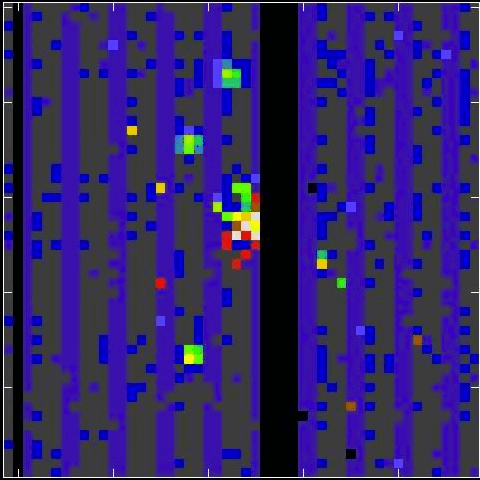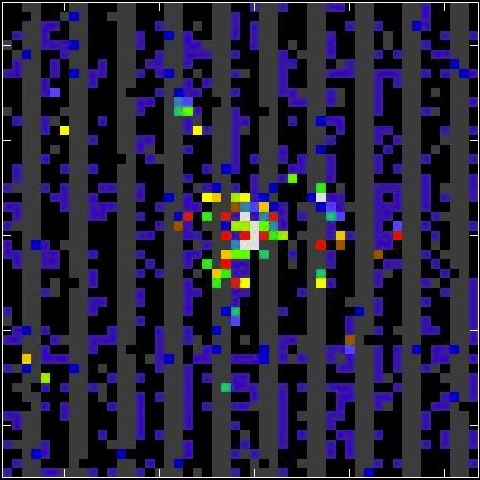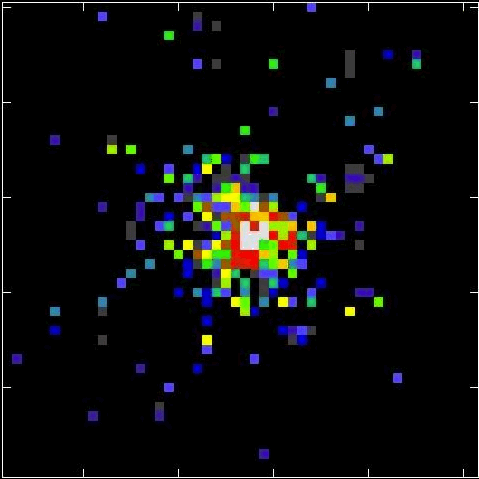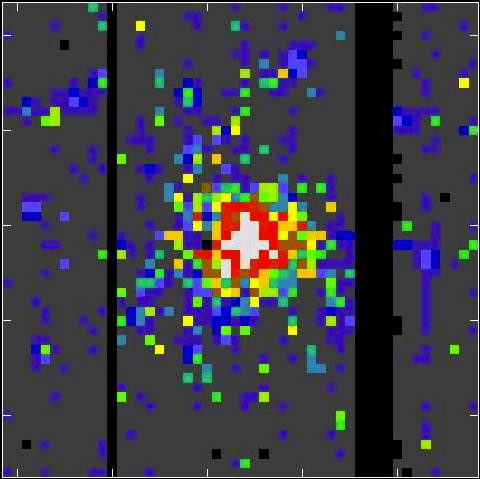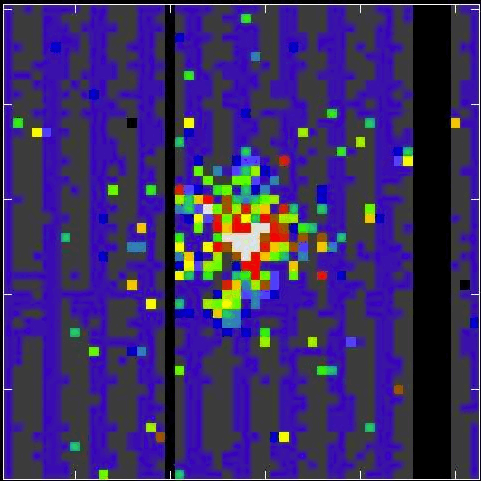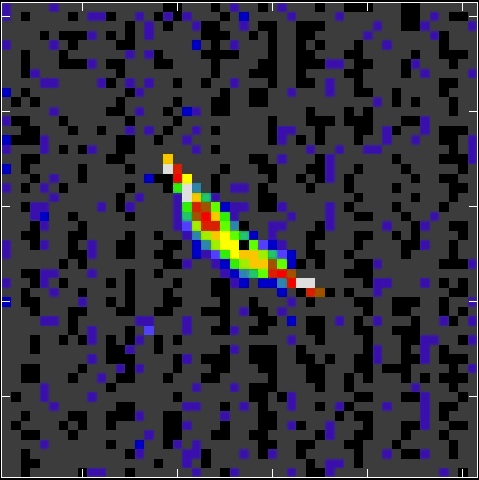
XRT Postage Stamp Image Photo Gallery
This document is intended to provide a quick overview of XRT Postage Stamps in order to help users distinguish between X-ray sources and cosmic rays.
When the XRT arrives at a possible new GRB position following an automated slew, it takes a series of short exposures to try to find a bright X-ray source in the field of view. The first exposure is always 0.1 s. Very bright sources will produce a centroid in this Short Image exposure (see the image of GRB 050117a below). If no source is found in this exposure, a 2.5 s exposure will be taken, and the XRT will attempt to find a source in this Long Image exposure. If it fails (due to lack of counts, because the standard deviation of the counts is too large or too small, or because the algorithm did not converge) it reports a Centroid Error message. If it succeeds, it sends a Postage Stamp image to the ground through TDRSS, and this is distributed through the GCN.
It is important to examine these images to check for invalid centroid positions, especially if the GCN/SWIFT_XRT_POSITION message from BACODINE has a note at the bottom suggesting that this is a possible cosmic ray event (that happens when the image is unusually bright - see more below). This rarely happens for real GRBs, but it does happen occasionally. An example is GRB 050422. The Postage Stamp image for this burst is shown below:
 The compact appearance of this
object is clearly not consistent with the XRT PSF (7.6 pixels HPD) or with the
typical distribution of pixels for a real X-ray image (see below).
The compact appearance of this
object is clearly not consistent with the XRT PSF (7.6 pixels HPD) or with the
typical distribution of pixels for a real X-ray image (see below).
Another important clue is the fact that the image gain > 1. The onboard software compresses the postage stamp image from 12 bits per pixel to 8 bits per pixel to reduce the telemetry message size. Some CRs deposit so much charge in some pixels that they saturate the lowest 8 bits, so the software applies a gain factor to the image to reduce the maximum pixel value to be less than 255. When this happens, the GCN Position Notice includes a warning at the bottom that notes that this is a possible cosmic ray. Extremely bright sources can also result in gain factors > 1. We have found that this method of identifying cosmic rays is not very accurate: for a sample of 379 XRT centroid images, 119 were flagged as possible cosmic rays (gain > 1), and 260 were not. Of the 119 flagged images, 8 were cosmic rays and 1 additional one was a real source with a cosmic ray going through it. Of the 260 that were not flagged as possible cosmic rays, 9 were actually cosmic rays, and 4 additional ones had a source plus a cosmic ray. The key point is that visual inspection is necessary to recognize cosmic rays and distinguish them from real sources. Please use the images in the galleries below as your guide to what CRs and real sources look like in XRT Postage Stamp images.
XRT Postage Stamp Images of X-ray sources
During centroiding tests, a number of X-ray sources were observed in Image Mode and Postage Stamp images were obtained. We show here a series of typical Postage Stamp images of X-ray sources, including the Postage Stamp images of GRB 050117a and GRB 050421. Note the much broader distribution of counts compared with the cosmic ray images that follow. The last few images are from bright GRBs. Note that even in the case of a bright source, the distribution of photons is quite broad.
|
Cen X-3 (2.5s) |
|
|
|
| |
|||
|
EXO0748 (2.5s) |
|
|
|
| | |||
|
GRBs |
GRB 050421 (2.5s) |
GRB 120305A (2.5s) |
GRB 120328A (2.5s) |
| |
|||
|
Bright GRBs |
GRB 120224A (2.5s) |
GRB 120324A (2.5s) |
GRB 120327A (2.5s) |
Rogues Gallery of Cosmic Rays
By contrast, we now present a rogues gallery of cosmic ray hits. These tend to be much more compact, although they sometimes have complex shapes, especially when two merge. Some of these are near the edge of the CCD, another clue that they are not GRBs (the accuracy of the BAT positions and S/C pointing puts most GRBs within 100 pixels of the center of the array at 300,300).
|
Simple Cosmic Rays |
|
|
|
|
| |
||||
|
Multiple Cosmic Rays |
|
|
|
|
| |
||||
|
Complex Cosmic Rays |
|
|
|
|
Finally, we show some examples in which real source images have cosmic rays within the 51 x 51 pixel Postage Stamp image. In cases like this, the position is likely to be incorrect, since it is calculated as the center of gravity of all pixels within the centroiding window (typically 80 x 80 pixels). The Postage Stamp window is always centered on the centroid position, so the offset of the true source image in the Postage Stamp gives a direct indication of the error in the centroid position (the Postage Stamp window is 2 x 2).
|
|
|
|







